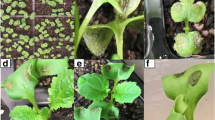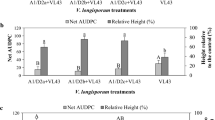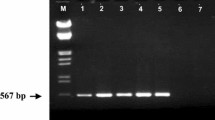Abstract
The effect of a seed treatment with the antagonistic bacteria Serratia plymuthica (strain HRO-C48) and/or Pseudomonas chlororaphis (strain MA 342) on the infection of oilseed rape with Verticillium longisporum was assessed with ten different cultivars. Soil was inoculated with microsclerotia and mycelium of a V. longisporum culture. Seeds were treated with rifampicin-resistant antagonistic bacteria at a rate of log10 6–7 cells per seed. Resistance against V. longisporum infection did not differ between cultivars and was generally low. A significant disease reduction recorded as area under disease progress curve (AUDPC) was obtained with both antagonistic rhizobacteria with no significant difference between the treatments. Percent of healthy plants was approximately 70% in all bacterial treatments. Significant differences were observed between the cultivars ranging from 46.5% (cultivar Titan) to 72.6% (Trabant). The combined use of both bacteria could not provide additional control effects. The bacterial density in the rhizosphere was not related to the control effect, but increased by log10 2 on infection with V. longisporum. Growth promotion effects were also not related to the control effect. At present, neither the application of chemical fungicides nor breeding for resistance against V. longisporum in oilseed rape can provide a solution for this increasingly problematic plant pathogen. The present results now open perspectives to control V. longisporum in oilseed rape by making use of cultivars, which express resistance against this pathogen on interaction with the antagonistic rhizobacteria S. plymuthica or P. chlororaphis.

Similar content being viewed by others
References
Bautista G, Mendoza H, Uribe D (2007) Biocontrol of Rhizoctonia solani in native potato (Solanum phureja) plants using native Pseudomonas fluorescens. Acta Biol Colomb 12:19–32
Berg G (1996) Rhizobacteria of oil seed rape antagonistic to Verticillium dahliae. J Plant Dis Prot 103:20–30
Berg G (2000) Diversity of antifungal and plant-associated Serratia plymuthica strains. J Appl Microbiol 88:952–960
Berg G, Fritze A, Roskot N, Smalla K (2001) Evaluation of potential biocontrol rhizobacteria from different host plants of Verticillium dahliae Kleb. J Appl Microbiol 156:75–82
Berg G, Roskot N, Steidle A, Eberl L, Zock A, Smalla K (2002) Plant-dependent genotypic and phenotypic diversity of antagonistic rhizobacteria isolated from different Verticillium host plants. Appl Environ Microbiol 68:3328–3338
Campbell CL, Madden LV (1990) Introduction to plant disease epidemiology. Wiley, New York, 532 pp
Collins A, Okoli CAN, Morton A, Parry D, Edwards SG, Barbara DJ (2003) Isolates of Verticillium dahliae pathogenic to crucifers are of at least three distinct molecular types. Phytopathology 93:364–376
Compant S, Duffy B, Nowak J, Clement C, Barka EA (2005) Use of plant growth-promoting bacteria for biocontrol of plant diseases: principle, mechanisms of action, and future prospects. Appl Environ Microbiol 71:4951–4959
De Vleesschauwer D, Höfte M (2007) Using Serratia plymuthica to control fungal pathogens of plants. CAB Rev 46:1–12
Debode J, Clewes E, De Backer G, Höfte M (2005) Lignin is involved in the reduction of Verticillium dahliae var. longisporum inoculum in soil crop residue incorporation. Soil Biol Biochem 37:301–309
Debode J, De Maeyer K, Perneel M, Pannecoucque J, De Backer G, Höfte M (2007) Biosurfactants are involved in the biological control of Verticillium microsclerotia by Pseudomonas spp. J Appl Microbiol 103:1184–1196
Eurostat (2007) Eurostat website and national data. http://epp.eurostat.ec.europa.eu
Eynck C, Koopmann B, Grunewaldt-Stoeker G, Karlovsky P, von Tiedemann A (2007) Differential interactions of Verticillium longisporum and Verticillium dahliae with Brassica napus detected with molecular and histological techniques. Eur J Plant Pathol 118:259–274
Fitt BDL, Gladders P, Turner JA, Sutherland KG, Welham SJ, Davies JM (1997) Prospects for developing a forecasting scheme to optimise use of fungicides for disease control on winter rape in the UK. Asp Appl Biol 48:135–142
Fitt BDL, Brun H, Barbetti MJ, Rimmer SR (2006) World-wide importance of Phoma stem canker (Leptosphaeria maculans and L. biglobosa) on oilseed rape (Brassica napus). Eur J Plant Pathol 114:3–15
Frankowski J, Lorito M, Schmid R, Berg G, Bahl H (2001) Purification and properties of two chitinolytic enzymes of Serratia plymuthica HRO-C48. Arch Microbiol 176:421–426
Hammoudi O (2007) Einfluss mikrobieller Antagonisten auf den Befall mit Phoma lingam und Verticillium dahliae var. longisporum an Raps (Brassica napus L. var. napus). Dissertation, Christian-Albrechts-University zu Kiel
Heale JB, Karapapa VK (1999) The Verticillium threat to Canada’s major oilseed crop: canola. Can J Plant Pathol 21:1–7
Hökeberg M (2006) Development and registration of biocontrol products—experience and perspectives gained from the bacterial seed treatment products Cedomon® and Cerall®. In: Proceedings of the international workshop “Implementation of biocontrol in practice in temperate regions—present and near future”, Research Centre Flakkebjerg, Denmark, November 1–3, 2005. DIAS Report 119, p 77
Hökeberg M, Gerhardson B, Johnsson L (1997) Biological control of cereal seed-borne diseases by seed bacterization with greenhouse-selected bacteria. Eur J Plant Pathol 103:25–33
Johnsson L, Hökeberg M, Gerhardson B (1998) Performance of the Pseudomonas chlororaphis biocontrol agent MA 342 against cereal seed-borne diseases in field experiments. Eur J Plant Pathol 104:701–711
Kalbe C, Marten P, Berg G (1996) Members of the genus Serratia as beneficial rhizobacteria of oilseed rape. Microbiol Res 151:400–433
Karapapa VK, Bainbridge BW, Heale JB (1997) Morphological and molecular characterization of Verticillium longisporum comb. nov., pathogenic to oilseed rape. Mycol Res 101:1281–1294
Khan A, Sutton JC, Grodzinski B (2003) Effect of Pseudomonas chlororaphis on Pythium aphanidermatum and root rot in peppers grown in small-scale hydroponic troughs. Biocontrol Sci Technol 13:615–630
Kurze S, Dahl R, Bahl H, Berg G (2001) Biological control of soil-borne pathogens in strawberry by Serratia plymuthica HRO-C48. Plant Dis 85:529–534
Lugtenberg BJJ, Chin-A-Woeng TFC, Bloemberg GV (2002) Microbe–plant interactions: principles and mechanisms. Antonie Van Leeuwenhoek 81:373–383
Mazzola M, Cook RJ (1991) Effects of fungal root pathogens on the population dynamics of biocontrol strains of fluorescent pseudomonads in the wheat rhizosphere. Appl Environ Microbiol 57:2171–2178
Messner R, Schweigkofler W, Schweigkofler M, Berg G, Prillinger H (1996) Molecular characterization of the plant pathogen Verticillium dahliae Kleb. using RAPD-PCR and sequencing of the 18S rRNA-gene. J Phytopathol 144:347–354
Mol L, van Riessen HW (1995) Effect of plant-roots in the germination of microsclerotia of Verticillium dahliae. Eur J Plant Pathol 101:673–678
Müller H, Berg G (2008) Impact of formulation procedures on the effect of the biocontrol agent Serratia plymuthica HRO-C48 on Verticillium wilt in oilseed rape. BioControl 53:905–916
Osborne DJ, McManus T (2005) Hormones, signals and target cells in plant development. Cambridge University Press, Cambridge
Robb J (2007) Verticillium tolerance: resistance, susceptibility or mutualism. Can J Bot 85:903–910
Rygulla W, Snowdon RJ, Eynck C, Koopmann B, von Tiedemann A, Lühs W, Friedt W (2007) Broadening the genetic basis of Verticillium longisporum resistance in Brassica napus by interspecific hybridization. Phytopathology 97:1391–1396
Rygulla W, Snowdon RJ, Friedt W, Happstadius I, Cheung W, Chen D (2008) Identification of quantitative trait loci for resistance against Verticillium longisporum in oilseed rape (Brassica napus). Phytopathology 98:215–221
Silva HSA, Romeiro RS, Mounteer A (2003) Development of a root colonization bioassay for rapid screening of rhizobacteria for potential biocontrol agents. J Phytopathol 151:42–46
Srivastava LM (2007) Plant growth and development—hormones and environment. Academic Press, San Diego
Tjamos EC, Tsitsigiannis DI, Tjamos SE, Antoniou PP, Katinakis P (2004) Selection and screening of endorhizosphere bacteria from solarized soils as biocontrol agents against Verticillium dahliae of solanaceous hosts. Eur J Plant Pathol 110:35–44
Whipps J (2001) Microbial interactions and biocontrol in the rhizosphere. J Exp Bot 52:487–511
Zeise K (1992) Screening for resistance to Verticillium dahliae Kleb. on oilseed rape (Brassica napus var. oleifera Metzger) under greenhouse conditions. Nachr Deut Pflanzenschutzd 44:125–128
Zeise K, von Tiedemann A (2001) Morphological and physiological differentiation among vegetative compatibility groups of Verticillium dahliae and V. longisporum. J Phytopathol 149:469–475
Zeise K, von Tiedemann A (2002) Host specialization among vegetative compatibility groups of Verticillium dahliae in relation to Verticillium longisporum. J Phytopathol 150:112–119
Zhou L, Hu Q, Johansson A, Dixelius C (2006) Verticillium longisporum and V. dahliae: infection and disease in Brassica napus. Plant Pathol 55:137–144
Acknowledgment
The scholarship by the DAAD (Deutscher Akademischer Austauschdienst) to the first author is highly appreciated.
Author information
Authors and Affiliations
Corresponding author
Additional information
Handling Editor: Monica Höfte.
Rights and permissions
About this article
Cite this article
Abuamsha, R., Salman, M. & Ehlers, RU. Differential resistance of oilseed rape cultivars (Brassica napus ssp. oleifera) to Verticillium longisporum infection is affected by rhizosphere colonisation with antagonistic bacteria, Serratia plymuthica and Pseudomonas chlororaphis . BioControl 56, 101–112 (2011). https://doi.org/10.1007/s10526-010-9308-8
Received:
Accepted:
Published:
Issue Date:
DOI: https://doi.org/10.1007/s10526-010-9308-8




